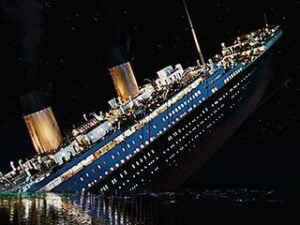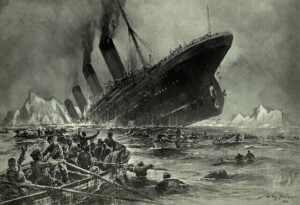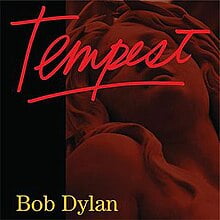One song from Tempest which deals with death and destruction but which has a fantastical but also somewhat whimsical humorous quality is the title track. This is a fourteen minute ‘epic’ consisting of fifty verses, all sung to the tune of a vaguely ‘Celtic’ waltz. The song was released in 2012 – a hundred years after the sinking of the Titanic – probably the most famous and dramatic shipwreck in history. The event was a huge news sensation at the time and created massive worldwide interest. Since then many books, articles and films have related versions of a story which has always retained its power to move audiences, especially as the ship was regarded as ‘unsinkable’. Its destruction by an iceberg on its maiden voyage to the USA has since become a symbol of the end of an era of deference towards the upper classes and of the kind of cultural blindness that led the world into the dreadful carnage of World War One. The 1997 blockbuster Titanic directed by James Cameron and starring Leonardo Di Caprio and Kate Winslet as Jack and Rose, two fictional ‘star crossed lovers’, became one of the most commercially successful movies of all time. The theme tune, a lachrymose power ballad belted out by Celine Dion called My Heart Will Go On (1997), became a huge worldwide hit.

Dylan’s song uses only a few elements of the true story. It also contains a series of religious and biblical allusions which appear to explore notions of free will and predestination. And in a bizarrely comical way, it also includes several references to Cameron’s film. Dylan avoids poetic language and metaphor, choosing instead the kind of language that was used in contemporary songs and newspaper reports about the disaster. The story is filtered through a fictional, ghostly character called the Watchman, who observes but has no control of events. Many of the events depicted are strange and illogical. This is enhanced by the ‘dreamily’ repetitive musical setting. It may even be that the whole song is a description of the Watchman’s dream, as many events in the narrative follow each other with a kind of surreal logic. Many colourfully symbolic characters appear in brief cameos. Dylan switches between realism, fiction and fantasy in a kind of burlesque of disparate ideas. He contemplates the theme of mortality, and all the questions that surround it, with a serene, smiling, contemplative detachment.

The song is entirely composed of four line stanzas, each of which has exactly eight syllables. The choice of this format appears to be deliberate. In the manner of a traditional ballad, there are no choruses or bridge sections. Many such songs were written and performed, some in the immediate wake of the event, and many others over the next few decades, by popular singers as well as blues and country artists. Among the most well known was Ernest ‘Pop’ Stoneman’s The Sinking of the Titanic (1926), which contains the refrain …It was sad when the great ship went down… This was used in several subsequent versions of the song, including one by Woody Guthrie. This version tells the story in a straightforward way, although it does emphasise that …The rich they declared they would not ride with the poor/ So they sent the poor below… Frank Hutchinson, a white blues singer, produced a kind of early ‘talkin’ blues’ version. ‘Hi’ Henry Brown’s Titanic Blues (1932) relates the story with a kind of po-faced relish. Many blues singers commented on the fact that Titanic supposedly did not allow black passengers to board; some even hinting at the sinking thus being a kind of divine retribution. A legend had grown up that the great black boxer Jack Johnson had been denied passage on the ship. This is recounted very sarcastically in Leadbelly’s The Titanic (1948), which includes the lines: …Jack Johnson want to get on board/ Captain said, “I ain’t hauling no coal”… What is surprising about many of these songs is that, instead of being tragic laments, they are often pithy and satirically humorous commentaries on an event which had already taken on iconic significance.

The most obvious genesis of Tempest lies in another song simply called The Titanic, popularised by the Carter Family. This was written by an obscure songwriter called Seth Newton Mize in the 1920s and was recorded by many country artists. Dylan uses a slowed down version of this song’s melody. He also borrows the character of the Watchman from this source; although the Watchman in Mize’s song purports to be a real character who is said to have been aboard the ship, rather than the semi-mythical figure that Dylan creates. Mize also implies that Captain Smith caused the disaster because he was drunk. It seems that the tradition of songs about the Titanic soon became one in which the legend, rather than the reality of the event, was emphasised. Dylan’s song also begins with a slightly altered version of Mize’s first verse, which runs:
…The pale moon rose in glory,
She’s drifting from golden west,
She told her sad, sad story:
Sixteen hundred have gone to rest…
Dylan’s song opens with the lines: …The pale moon rose in its glory/ Over the Western town… and continues …She told a sad, sad story/ Of the great ship that went down… the last line here incorporating the refrain that occurs in Stoneman and other singers’ versions. The idea of the moon ‘telling the story’ is a rather poetically wistful one, although – in the context of Dylan’s incorporation of elements of Cameron’s film – the woman who relates the events here may be the character of Rose (Kate Winslet). The film begins and ends with the words of the centenarian Rose and the whole story of what happened in 1912 is presented as a flashback. Mize’s first line also – by a happy co-incidence – contains the word ‘rose’.

The next few verses are couched in the kind of clichés that were popular around the time of the disaster itself …’Twas the fourteenth day of April… The night was bright with starlight…. The chandeliers were swaying… The ship was …sailing into tomorrow/ to a golden age foretold… But there is already a premonition of disaster as …all the lords and ladies… are said to be …heading for their eternal home… This account sounds very much like florid journalistic description. The orchestra on board the ship is playing …songs of faded love…. Then we are introduced to the first of the many characters who will make their entrances and exits: …The Watchman he was dreaming as the ballroom dancers twirled… But then there is a very odd shift of tone: …He dreamed the Titanic was sinking into the underworld… In his dream, the Watchman imagines the ship to be sinking not beneath the sea but beneath the earth. The references to ‘the golden age’ and ‘the underworld’ evoke elements of classical mythology. But as Dylan recounts the story to the slow waltz tune, there is no sign of panic or alarm, or even drama, in his voice. He merely sounds amused throughout.

There is an even more surprising shift in the next verse. If we are expecting the song to be any kind of serious spiritual discourse we are about to be disillusioned …Leo took his sketch book/ He was often so inclined/ He closed his eyes and painted/ The scenery in his mind… There is no doubt here that the character being described is one of the two main protagonists of the movie. Dylan refers to him not as ‘Jack’ (the character’s name) but as ‘Leo’, a jokily abbreviated form of Leonardo (as in Di Caprio). In the film, Jack Dawson is a poor artist who in one scene sketches the beautiful and aristocratic Rose in the nude, which leads onto a ‘steamy’ erotic encounter. But Dylan tells a different tale. ‘Cupid’ (the God of love in classical mythology) shoots an arrow into ‘Leo’ and he immediately ‘falls into the lap’ of the nearest woman. Already the events of the song appear to have merged with the Watchman’s dream. Events now take place with dream-like rapidity and logic. Suddenly Leo discovers that the ship is flooding, then we learn that the ‘smokestack is leaning sideways’ as …heavy feet begin to pound… while Leo …walks into a whirlwind… The real Titanic did not, of course, encounter a whirlwind or a ‘tempest’.

We now hear that …dead bodies are floating in the double-bottomed hull… (a ‘real life’ detail), while the engines explode and the bow splits apart. Passengers are flung around the ship in scenes of utter mayhem …The veil was torn asunder… is a reworking of lines in Matthew 27 describing the destruction of the Temple in Jerusalem. The next few verses introduce us to numerous (mostly fictional) characters. The first one, Wellington (the name of a famous general and thus presumably some kind of ‘stiff’ military character), who sees his furniture moving around and then …straps on both his pistols… thinks he will need to defend himself against some kind of threat, although such an assumption is of course ridiculous. We see some the horrors of the tragedy through his eyes. ‘Friends and lovers’ are said to be …clinging to each other side by side… while …mothers and their daughters… …jump into the icy waters… presumably to an almost certain death. We then see ‘Mr. Astor’ (John Jacob Astor IV, a multi millionaire and one of the richest people in the USA) kissing ‘his darling wife’. Astor was perhaps the most famous casualty of the disaster and is mentioned in most of the songs about the event. Leadbelly’s version includes a similar account of him kissing his wife. Astor also features as a character in Cameron’s movie. Mance Lipscomb’s The Sinking of the Titanic states, rather acidly, that …Jacob Astor was a millionaire, had plenty money to spare/ But when the Titanic was sinking, Lord, he could not pay his fare….

We are also told that …Brother rose up against brother/ In every circumstance/ They fought and slaughtered each other/ In a deadly dance… For a moment we seem to be transported onto a battlefield, with the description of brothers fighting each other evoking the events of American Civil War. Meanwhile, the slow waltz tune continues unabated. The dream-narrative continues to ‘cut’ in and out of the Titanic scenario. We hear that the lifeboats are being lowered, but then that …there were traitors, there were turncoats/ Broken backs and broken necks… none of which was reported as happening on the real sinking ship or in Cameron’s film. A bishop leaves his cabin to try to help, but realises that everything is hopeless. He merely turns his eyes heavenwards and addresses God by saying …The poor are yours to feed…. The ineffectuality of this representative of the church is contrasted with that of ‘Jim Dandy’, who cannot swim but gives up his seat on a lifeboat to a crippled child. ‘Jim Dandy’ is a fictional character who is known for rescuing others and who appears in a 1956 hit song by Laverne Baker. As Dandy sees ‘the starlight from the east’ he knows he will die soon but …his heart was now at peace…

As chaos takes over we return to our friend Leo, who can now make no sense of what is happening in this bizarre, hallucinatory scenario: …Leo turned to Cleo/ “I think I’m going mad”/ But he’d lost his mind already/ Whatever mind he had… We are never told who ‘Cleo’ is. Meanwhile the description of Leo trying to …block the doorway to save all those from harm/ Blood from an open wound pouring down his arm… seems to be a version of the scenes in the movie where Jack performs heroics in order to save some of the passengers. But this is the last we will hear of Leo and we will never find out whether he shares Jack Dawson’s fate. In the next verse we hear that: …Petals fell from the flowers/ ‘Till all of them were gone/ In the long and dreadful hours/ The wizard’s curse played on… The mention of the ‘wizard’s curse’ suggests that this dream-version of the sinking of the ship is indeed a kind of Hollywood movie in which the passengers have been bewitched by an unseen manipulator. Given that the trouble with the ship appears to have been started by a whirlwind, perhaps this ‘remake’ of the famous movie has somehow incorporated elements of The Wizard of Oz. Dorothy and her friends are however, nowhere to be seen.

Various other characters now contemplate their fate. ‘The host’ (presumably the ship’s designer, Thomas Andrews) is shown calmly drinking brandy as the ship goes down. The captain stoically remains at his post. We are told that he …remembered bygone years…. and that …He read the Book of Revelations and he filled his cup with tears…. Although one hardly imagines him having much time for reading as the ship sinks, in one scene in the film a Catholic priest is shown reading a passage from the final book in the Bible. Many other people perished, it seems, who would be …Nameless here forever more… (a line borrowed from Poe’s The Raven) and that, when the Reaper’s work was finished …sixteen hundred had gone to rest… These are described as …the good, the bad, the rich, the poor/ The loveliest and the best… As the crowds are pictured waiting at the landing place for the survivors to arrive, someone concludes that …There is no understanding on the judgment of God’s hand…. Finally we see the Watchman again, still dreaming, as the ship sinks and the waltz fades away. Dylan presents the story of the Titanic – or, more accurately – the legend of the Titanic, as if it is a mythical construct. He combines various aspects of songs about the disaster with a few elements from the film and some apparently random characters in a cartoon-like presentation of the tragic story which revels in its comic ambiguity.

Many Dylan fans found Tempest especially puzzling. It was hardly surprising that he seemed to have little interest in the historical details of the actual disaster. But on hearing that Dylan had written a lengthy song about the sinking of the Titanic, it was perhaps expected that he would produce a long and serious meditation on the subject – a sequel, perhaps, to Desolation Row in which the lines …the Titanic sails at dawn/ And everybody’s shouting “Which side are you on?”… symbolise the futility of ‘taking sides’ in a political or philosophical argument when humanity is on the brink of potential disaster. Instead of this, Dylan produces a comic pastiche. Yet the story of the sinking ship will always be symbolic of the futility of attempting to defy ‘the judgement of God’s hand’. He illustrates this by including characters from the poem Under Ben Bulben by W.B. Yeats (a contemporary poet at the time of the sinking). The poem, a meditation on the possibility of an afterlife, includes the lines …Calvert and Wilson, Blake and Claude/ Prepared a rest for the people of God… The four figures are all visionary artists. Dylan cuts the list down to three and changes ‘Calvert’ to ‘Calvin’. John Calvin was one of the leading founders of Protestantism and was a major proponent of the idea that human actions are predestined by God. William Blake, whose religious impulses were far more libertarian, was opposed to such a doctrine. Dylan playfully imagines these figures ‘gambling in the dark’ over their fate. We know, however, that these actions will be entirely futile. We are informed emphatically that …Not one of them would live to tell the tale or disembark… By setting this dispute on the Titanic Dylan implies that debates about predestination and free will are as much a waste of time as Wellington arming himself. In the context of his other comic songs about ageing, the implication here seems to be that he no longer wishes to waste his time in ‘idle speculation’. Life, while you are lucky enough to still have it, is to be lived and treasured in every moment.



Leave a Reply